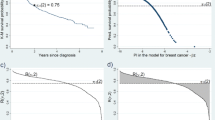Abstract
Calibration is an important measure of the predictive accuracy for a prognostic risk model. A widely used measure of calibration when the outcome is survival time is the expected Brier score. In this paper, methodology is developed to accurately estimate the difference in expected Brier scores derived from nested survival models and to compute an accompanying variance estimate of this difference. The methodology is applicable to time invariant and time-varying coefficient Cox survival models. The nested survival model approach is often applied to the scenario where the full model consists of conventional and new covariates and the subset model contains the conventional covariates alone. A complicating factor in the methodologic development is that the Cox model specification cannot, in general, be simultaneously satisfied for nested models. The problem has been resolved by projecting the properly specified full survival model onto the lower dimensional space of conventional markers alone. Simulations are performed to examine the method’s finite sample properties and a prostate cancer data set is used to illustrate its application.





Similar content being viewed by others
References
Box GEP, Draper NR (1987) Empirical model-building and response surfaces. Wiley, New York
Cai Z, Sun Y (2003) Local linear estimation for time-dependent coefficients in Cox’s regression models. Scand J Stat 30:93–111
Demler OV, Paynter NP, Cook NR (2015) Tests of calibration and goodness-of-fit in the survival setting. Stat Med 34:1659–1680
DiCiccio TJ, Monti AC, Young GA (2006) Variance stabilization for a scalar parameter. J R Stat Soc Ser B 68:281–303
Gerds TA, Schumacher M (2007) Efron-type measures of prediction error for survival analysis. Biometrics 63:1283–1287
Gneiting T, Raftery AE (2007) Strictly proper scoring rules, prediction, and estimation. J Am Stat Assoc 102:359–378
Graf R, Schmoor C, Sauerbrei W, Schumacher M (1999) Assessment and comparison of prognostic classification schemes for survival data. Stat Med 18:2529–2545
Grambsch P, Therneau T (1994) Proportional hazards tests and diagnostics based on weighted residuals. Biometrika 81:515–526
Heller G, Seshan V, Moskowitz CS, Gönen M (2017) Inferential methods to assess the difference in the area under the curve from nested binary regression models. Biostatistics 18:260–274
Horowitz JL (1998) Semiparametric Methods in Econometrics. Springer, New York
Hougaard P (1986) Survival models for heterogeneous populations derived from stable distributions. Biometrika 73:387–396
Korn EL, Simon R (1990) Measures of explained variation for survival data. Stat Med 9:487–503
Kosorok MR, Lee BL, Fine JP (2004) Robust inference for univariate proportional hazards models frailty regression models. Ann Stat 32:1448–1491
Lawless JF, Yuan Y (2010) Estimation of prediction error for survival models. Stat Med 29:262–274
Lin DY, Wei LJ, Ying Z (1993) Checking the cox model with cumulative sums of martingale-based residuals. Biometrika 80:557–572
Martinussen T, Scheike T (2006) Dynamic regression models for survival data. Springer, New York
Peng L, Huang Y (2007) Survival analysis with temporal covariate effects. Biometrika 94:719–733
Pepe MS, Kerr KF, Longton G, Wang Z (2013) Testing for improvement in prediction model performance. Stat Med 32:1467–1482
Rosthoj S, Keiding N (2004) Individual survival time prediction using statistical models. Lifetime Data Anal 10:461–472
Saad F, Fizazi K, Jinga V, Efstathiou E, Fong PC, Hart LL et al (2015) Orteronel plus prednisone in patients with chemotherapy naive metastatic castration-resistant prostate cancer (ELM-PC 4): a double-blind, multicentre, phase 3, randomised, placebo-controlled trial. Lancet Oncol 16:338–348
Schemper M (1990) The explained variation in proportional hazards regression. Biometrika 77:216–218
Tian L, Zucker D, Wei LJ (2005) On the Cox model with time-varying regression coefficients. J Am Stat Assoc 100:172–183
Tian L, Cai T, Goetghebeur E, Wei LJ (2007) Model evaluation based on the sampling distribution of estimated absolute prediction error. Biometrika 94:297–311
Uno H, Cai T, Tian L, Wei LJ (2007) Evaluating prediction rules for t-year survivors with censored regression models. J Am Stat Assoc 102:527–537
Wellek S (1993) A log-rank test for equivalence of two survivor functions. Biometrics 49:877–881
Acknowledgements
I would like to thank the editors and reviewers for comments that led to the improvement in the content of this work. This work was supported by NIH Grants R01CA207220 and P30CA008748.
Author information
Authors and Affiliations
Corresponding author
Additional information
Publisher's Note
Springer Nature remains neutral with regard to jurisdictional claims in published maps and institutional affiliations.
Electronic supplementary material
Below is the link to the electronic supplementary material.
Supplementary Material
Supplementary material contains the appendix with the proof of the Theorem and the supplemental figures and tables cited in the text.(pdf 542KB)
Rights and permissions
About this article
Cite this article
Heller, G. The added value of new covariates to the brier score in cox survival models. Lifetime Data Anal 27, 1–14 (2021). https://doi.org/10.1007/s10985-020-09509-x
Received:
Accepted:
Published:
Issue Date:
DOI: https://doi.org/10.1007/s10985-020-09509-x




